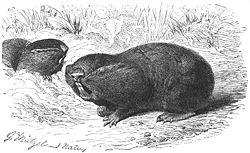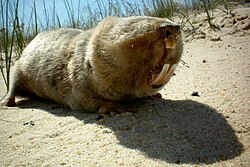
Spalacidae is a family of mammals in the order Rodentia and part of the Myomorpha suborder. Members of this family are called spalacids, and include blind mole-rats, bamboo rats, mole-rats, and zokors. They are found in Asia, eastern Africa, and eastern Europe, primarily in forests, shrublands, and grasslands, though some species can be found in deserts or savannas. They range in size from the Middle East blind mole-rat, at 13 cm (5 in) with no tail, to the large bamboo rat, at 48 cm (19 in) plus a 20 cm (8 in) tail. Spalacids are primarily herbivores, and eat roots, bulbs, tubers, grass, and seeds, with some species also eating insects. Few spalacids have population estimates, but four species—the giant root-rat, Mehely's blind mole-rat, Podolsk blind mole-rat, and sandy blind mole-rat—are categorized as endangered, while the Oltenia blind mole-rat is categorized as critically endangered.
Contents
- Conventions
- Classification
- Spalacids
- Subfamily Myospalacinae
- Subfamily Rhizomyinae
- Subfamily Spalacinae
- Subfamily Tachyoryctinae
- References
- Sources
The 23 extant species of Spalacidae are divided into 7 genera, divided into 4 subfamilies. Myospalacinae contains 6 species of zokors in 2 genera, Rhizomyinae contains 4 species of bamboo rats in 2 genera, Spalacinae contains 11 species of blind mole-rats in 2 genera, and Tachyoryctinae contains a single genus of 2 mole-rat species. Several extinct prehistoric spalacid species have been discovered, though due to ongoing research and discoveries, the exact number and categorization is not fixed. [1]























